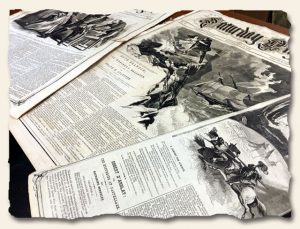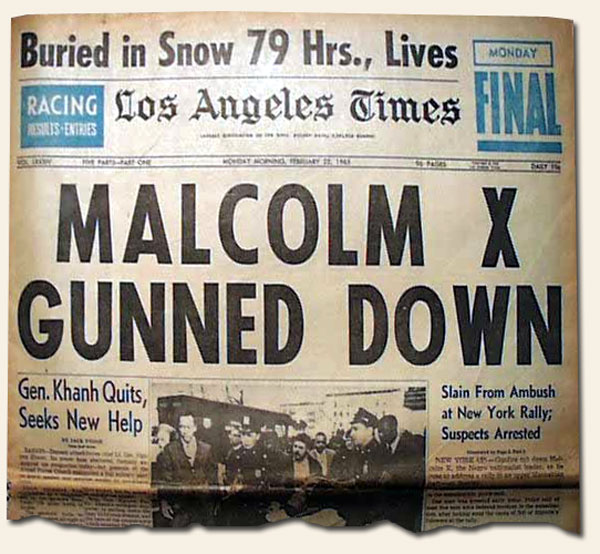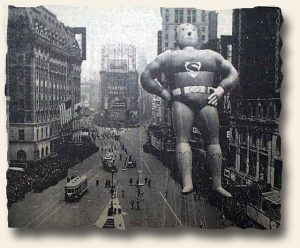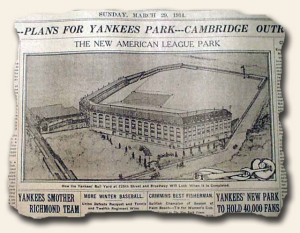I’m New Here: Week Thirty-Three…
October 11, 2019 by Stephanie Williams · Leave a Comment
 This week, while pulling issues that contain Emily Dickinson death notices, I read about the first public appearance of Dr. Oliver Wendell Holmes and also the institution of the Income Tax. As this was in 1886, I was surprised at the latter. Actually, I was surprised to see so many famous names and events in just a ten day span within that May. Oscar Wilde was hosting parties, Chicago was caught up in the Haymarket affair, and Coca-Cola was invented by a pharmacist. The rabbit trail I chose to follow (after investigating this whole Federal Income Tax thing that has historically been attributed to Woodrow Wilson’s presidency almost thirty years later) began with the following words to the Editor of the New York Times: “Mr. Putnam’s remarks on the impropriety of republishing [Washington] Irving’s works in their unrevised form, have but one fault; they are not strong enough.”
This week, while pulling issues that contain Emily Dickinson death notices, I read about the first public appearance of Dr. Oliver Wendell Holmes and also the institution of the Income Tax. As this was in 1886, I was surprised at the latter. Actually, I was surprised to see so many famous names and events in just a ten day span within that May. Oscar Wilde was hosting parties, Chicago was caught up in the Haymarket affair, and Coca-Cola was invented by a pharmacist. The rabbit trail I chose to follow (after investigating this whole Federal Income Tax thing that has historically been attributed to Woodrow Wilson’s presidency almost thirty years later) began with the following words to the Editor of the New York Times: “Mr. Putnam’s remarks on the impropriety of republishing [Washington] Irving’s works in their unrevised form, have but one fault; they are not strong enough.”
It is Autumn with a capital “A” in the northeast United States where, flanked by hilly vistas of multi-hued splendor, every street corner proclaims this the month of Hallowe’en. Washington Irving, author of the famous ghost story “The Legend of Sleepy Hollow”, could easily have been one of the serialized authors featured in the 1869 “Saturday Night” issues I have been pulling for a Philadelphia area collector. And October is definitely the time of year in which strange, extraordinary and macabre stories would have provided thrilling weekend entertainment to a 19th century culture blessedly devoid of electronic clamor.
I didn’t know about Irving’s first published work, or the misinformation campaign to hype interest prior to the release of A History of New York. I read about his “Knickerbocker” alter ego whose fictitious disappearance sparked a national following. This moniker influenced sports teams, architectural structures, social groups, and even a toy company. To this day, a resident of Manhattan is a Knickerbocker — nicknamed after a man who never was.
So, I am thankful for the censure that drew my attention away from the tax tables and the following words of “THE NEW INTERNAL REVENUE LAW. Topics of Interest to Everybody”:
Among these the Tax and Tariff laws are prominent, possessing an interest for every one, inasmuch as they most sensibly affect the cost of living, enhancing the prices of everything we eat, drink, or wear, adding to the value of articles of both necessity and luxury. The Tax law especially appeals directly to our pockets; and we find that a share of our profits from manufacturing any article, as well as a proportion of the income which we annually receive, is due to the Government.
I would much rather consider impropriety of a literary kind.
Great Headlines Speak For Themselves… Malcolm X assassinated…
March 12, 2018 by The Traveler · 2 Comments
The best headlines need no commentary. Such is the case with the LOS ANGELES TIMES, February 22, 1965: “MALCOLM X GUNNED DOWN“…
Macy’s Thanksgiving Day Parades through time…
November 22, 2017 by GuyHeilenman · Leave a Comment
 Happy Thanksgiving! Whereas we have written multiple posts to celebrate Thanksgiving which focus on Presidential Thanksgiving Proclamations, we thought this year we would give a shout-out to the resiliency of New Yorkers by directly the spotlight on the annual Macy’s Thanksgiving Day Parades through time. Please enjoy this walk back through history:
Happy Thanksgiving! Whereas we have written multiple posts to celebrate Thanksgiving which focus on Presidential Thanksgiving Proclamations, we thought this year we would give a shout-out to the resiliency of New Yorkers by directly the spotlight on the annual Macy’s Thanksgiving Day Parades through time. Please enjoy this walk back through history:
Macy’s Thanksgiving Day Parades
The Traveler… spreading the word… named director…
May 16, 2016 by The Traveler · 2 Comments
 Today I journeyed to New York City by the way of the New-York Spectator of May 15, 1816. There I found the announcement of the formation of “The American Bible Society” which still exist today. Some of the founding/early members include Elias Boudinot, who had been President of the Continental Congress from 1782 to 1783, John Jay, the first Chief Justice of the U.S. Supreme Court, Frederick Theodore Frelinghuysen, Daniel Coit Gilman, Edwin Francis Hyde, and Francis Scott Key. The front page report announced the formation of the organization and the third page report contained their resolutions. “… The leading feature of the constitution limits the operations… to the distribution of the bible without note or comment…”.
Today I journeyed to New York City by the way of the New-York Spectator of May 15, 1816. There I found the announcement of the formation of “The American Bible Society” which still exist today. Some of the founding/early members include Elias Boudinot, who had been President of the Continental Congress from 1782 to 1783, John Jay, the first Chief Justice of the U.S. Supreme Court, Frederick Theodore Frelinghuysen, Daniel Coit Gilman, Edwin Francis Hyde, and Francis Scott Key. The front page report announced the formation of the organization and the third page report contained their resolutions. “… The leading feature of the constitution limits the operations… to the distribution of the bible without note or comment…”.
Also in the issue is an article “Bank of the United States” in which “The President and Senate have appointed the following named, Directors of the Bank of the United States… John Jacob Astor, of the city of New-York…”. Mr. Astor was known as the first prominent member of the Astor family, the first multi-millionaire in the United States and the fifth-richest man in American history.
~The Traveler
Guess he wasn’t thinking…
June 8, 2012 by TimHughes · Leave a Comment
The January 8, 1902 issue of the “Wellsville Daily Reporter” of New York has an interesting article of a construction worker who apparently wasn’t thinking when he attempted to thaw frozen dynamite (see below).
Perhaps the precursor to the shell game?
February 18, 2012 by GuyHeilenman · Leave a Comment
The following “invention” appeared in the Scientific American dated November 23, 1878. Perhaps the “shell game” was developed to take advantage of the abundance of this unsold product?
Interesting items on the Underground Railroad…
February 11, 2012 by TimHughes · 1 Comment
The “Supplement to the New-York Daily Tribune“, May 11, 1849, has the following at the top of the front page. Note the incredibly strong pro-slavery bias in the first paragraph:
The Traveler… we’ve come a long way baby…
October 17, 2011 by The Traveler · Leave a Comment
This week I traveled to The Woman’s Journal of October 14, 1911. This issue was celebrating after waiting two days for the outcome of the California election on the  suffrage vote… “reading first with despair, then with growing hope and finally with jubilation the conflicting reports that came over the wires… Praise God. Victory ours. Four thousand majority.” The front page contains a photo of the Statue of Liberty with six stars surrounding her. These represented the states which have passed the “equal suffrage” — Wyoming, Colorado, Utah, Idaho, Washington and now adding California.
suffrage vote… “reading first with despair, then with growing hope and finally with jubilation the conflicting reports that came over the wires… Praise God. Victory ours. Four thousand majority.” The front page contains a photo of the Statue of Liberty with six stars surrounding her. These represented the states which have passed the “equal suffrage” — Wyoming, Colorado, Utah, Idaho, Washington and now adding California.
The 1848 Seneca Falls Convention is traditionally viewed as the beginning of the Women’s Rights Movement. It was not until June 4, 1919 that Congress sent the proposal for the 19th Amendment, the woman’s right to vote, and then it was not until August 18, 1920 that the final ratification was passed, by the vote from Tennessee. It was a long road, but “we’ve come a long way baby” since then!
~The Traveler
What happened to this Yankee stadium?
August 22, 2011 by TimHughes · 1 Comment
 A question for all the Yankee fans out there: what happened to this stadium?
A question for all the Yankee fans out there: what happened to this stadium?
The March 29, 1914 issue of the “New York Times” shows the “…Plans For Yankees Park…” with a detailed drawing captioned: “How the Yankees’ Ball Yard at 225th Street and Broadway Will Look When it is Completed.” and beneath which is a detailed article headed: “Yankees’ New Park To Hold 40,000 Fans” “Double-Deck Grand Stand of Steel and Concrete to be Completed in September“. The article (see photos) provides many details of the new ball park, however I can find no record of it being built.
The Yankee website notes that the team shared the Polo Grounds with the Giants from 1913 through the early 1920’s until the stadium called the “House that Ruth Built” was ready for use in 1923. Does anyone know the history of this “mystery stadium” supposedly built in 1914?
The Civil War… 150 years ago today… May 4, 1861
May 4, 2011 by TimHughes · Leave a Comment
We continue our weekly feature of reflecting upon the appropriate 150 year old issue of “Harper’s Weekly” from the perspective of a subscriber in 1861:
 The front page of today’s May 4, 1861 issue portrays what seems to me an eerie sight. It is captioned: “The House-Tops In Charleston During the Bombardment of Sumter” and shows what appears to be hundreds of men and women watching the battle in the distance, smoke rising from the forts & what appears to be bomb blasts as well. It is as if they are watching fireworks on the 4th of July–but this is war! Several of the women are shown doubled over in grief. It must have been a distressing event to witness.
The front page of today’s May 4, 1861 issue portrays what seems to me an eerie sight. It is captioned: “The House-Tops In Charleston During the Bombardment of Sumter” and shows what appears to be hundreds of men and women watching the battle in the distance, smoke rising from the forts & what appears to be bomb blasts as well. It is as if they are watching fireworks on the 4th of July–but this is war! Several of the women are shown doubled over in grief. It must have been a distressing event to witness.
The maps are always helpful in providing a geographic perspective of the war. A full page map shows: “…Part of Maryland and Virginia, Showing the Probable Theatre of the War”. It’s a great view of Chesapeake Bay, showing Baltimore to the north and Norfolk to the south, and including Washington, D.C. & other towns as well. I didn’t realize the nation’s capital was so close to the Bay.
Another full page shows: “The Great Meeting in Union Square, New York, to Support the Government” which includes both soldiers and citizens. Two other prints show the support for the war with the “Boston Regiments Embarking for Washington…” and a parade of “The Seventh Regiment, Marching Down Broadway to Embark for the War” with cheering fans along the way, even hanging from the windows and cheering from the rooftops–flags everywhere. It must have been a very special sight!
The drama & tragedy of war is certainly depicted in the print: “First Blood–The Sixth Mass. Regiment Fighting Their Way Through Baltimore”. It shows nearly hand-to-hand fighting, long rifles involved with killed & wounded on the ground. The daily reports can’t relay the violence a single print portrays.
Other prints are interesting as well showing the huge size of the “Stevens’ Bomb-Proof Floating Battery” (but made out of wood: how can it be bomb-proof?), “The Heroes of Fort Sumter” and soldiers preparing for war.


